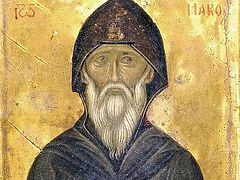 Photo: vimaorthodoxias.gr Long before St John, hegumen of the monastery on Mount Sinai, wrote his immortal book called The Ladder, the image of a ladder was already present in the Scriptures, and hence in the minds of Christians. I am referring to the famous night vision of Jacob, which he experienced when on the way to Haran. In his dream, the patriarch saw a ladder set up on the earth and its top reached to heaven, and the angels of God were ascending and descending on it. The Lord stood above it and spoke with Jacob, promising him great things (cf. Gen 28.10–22). This event is the origin of those hymns which describe the Mother of God as being herself a “ladder”. The Akathistos Hymn, for example: “Rejoice, heavenly ladder by which God came down”.
Photo: vimaorthodoxias.gr Long before St John, hegumen of the monastery on Mount Sinai, wrote his immortal book called The Ladder, the image of a ladder was already present in the Scriptures, and hence in the minds of Christians. I am referring to the famous night vision of Jacob, which he experienced when on the way to Haran. In his dream, the patriarch saw a ladder set up on the earth and its top reached to heaven, and the angels of God were ascending and descending on it. The Lord stood above it and spoke with Jacob, promising him great things (cf. Gen 28.10–22). This event is the origin of those hymns which describe the Mother of God as being herself a “ladder”. The Akathistos Hymn, for example: “Rejoice, heavenly ladder by which God came down”.
In the fourth week of Lent, all church talk should be about this metaphor of a ladder, inasmuch as the fourth Sunday and the week following are called after “John of The Ladder”. However, his book is such that throughout the whole year a priest can constantly heal the minds and souls of his flock by choosing from it the necessary and essential sayings, depending on the situation in the parish or monastery. Talking about The Ladder only once a year means dooming oneself to conversation of a superficial nature, and that is more or less useless. So, leaving the practical mastery of the book to those in charge of souls, let us talk about the following.
A ladder—no matter what it is made of, whether metal, wood, or rope—is a cultural phenomenon; like an agricultural plough or a hunting bow, it is invented and made by man. And man is always surrounded by the works of his own hands; he always lives in two worlds—God’s world and the world of man-made things. The latter are a product of what are also called “second nature” skills. For example, the gospel mentions grain and fish, which are created by God, but also a coin and a boat, which pertain to man-made reality and these “second nature” skills—as does a ladder. It leads from the bottom up, and from the top down (the angels both ascended and descended on it). But you can only climb up gradually, whereas you can tumble down quickly, even upside down. Little boys sliding down a banister are familiar with the thrill of a fast descent, but those monks who are being pulled down by demons on the icon depicting St John’s Ladder know that there is no fun in it.
A ladder, though seemingly simple, is a clever invention that speaks volumes. It enables one to ascend gradually, one step at a time, to a height that an ordinary person could never reach by jumping or climbing. Even an old man who is suffering from shortness of breath and who needs to rest for a long time on each rung can eventually reach a considerable height. This is undeniably an image of spiritual labours. We could all rise high, if we would slowly and steadily move in the right direction.
Is it not surprising that one can learn a lot from such simple everyday things? It turns out that, bearing as he does an ineradicable image of the Creator, man is himself able to create meaningful things. G. K. Chesterton speaks excellently about this in his book The Everlasting Man, when discussing the symbol of a key in a Christian context. It is with pleasure that I quote from the relevant passage, because it is an example of deep thinking even when contemplating quite commonplace things.
The Christian creed, he writes, “is like a key in three respects; which can be most conveniently summed up under this symbol. First, a key is above all things a thing with a shape. It is a thing that depends entirely upon keeping its shape. The Christian creed is above all things the philosophy of shapes and the enemy of shapelessness. That is where it differs from all that formless infinity, Manichean or Buddhist, which makes a sort of pool of night in the dark heart of Asia”. As Chesterton is making clear, if a key loses its shape it is no longer a key. Furthermore, if the shape is incorrect, the door will not open. Similarly, Christianity has clear-cut outlines; it is opposed to any kind of vagueness.
Secondly, Chesterton continues, “the shape of a key is in itself a rather fantastic shape. A savage who did not know it was a key would have the greatest difficulty in guessing what it could possibly be. And it is fantastic because it is in a certain sense arbitrary. A key is not a matter of abstractions; in that sense a key is not a matter of argument. It either fits the lock or it does not. It is useless for men to stand disputing over it, considered by itself; or reconstructing it on pure principles of geometry or decorative art. It is senseless for a man to say he would like a simple key; it would far more sensible for him to do his best with a crowbar.
“And thirdly, as the key is necessarily a thing with a pattern, so this one [= the key, or keys, given by Christ to Peter] was one having in some ways a rather elaborate pattern. When people complain of the religion being so early complicated with theology and things of that kind, they forget that the world had not only got into a hole, but had got into a whole maze of holes and corners. The problem itself was a complicated problem; it did not in the ordinary sense merely involve anything so simple as sin. It was also full of secrets, of unexplored and unfathomable fallacies, of unconscious mental diseases, of dangers in all directions. If the faith had faced the world only with the platitudes about peace and simplicity that some moralists would confine it to, it would not have had the faintest effect on that luxurious and labyrinthine lunatic asylum. It is enough to say here that there was undoubtedly much about the key that seemed complex, indeed there was only one thing about it that was simple. It opened the door.”1
Continuing in this spirit to reflect on the concept of a ladder, we see 1) that it has a purpose; 2) that the upward movement should be gradual and is associated with effort; 3) and that the higher you climb, the greater the risk of falling.
St John’s book is not unique in setting before us such guidelines as these. The Ten Commandments that Moses received on the mountain already contain the idea of an ascent. Beginning by forbidding sin at the level of its bodily manifestation (do not kill, do not steal, do not commit adultery), the commandments end with the words “do not covet”; that is, they penetrate the inner world of man, and judge not actions but intentions.
In the same way, Christ’s teaching in the Beatitudes begins with words about the poor in spirit, and gradually progresses to those who are persecuted for the truth before finally, despite everything, ending with a call to His followers to “rejoice and be exceedingly glad” about their reward in heaven. This challenging ascent from the lesser to the greater is also, as it were, a “ladder”. One that gradually leads a person to true bliss.
Life must not be thought of as a Brownian motion, a series of random movements and fluctuations. Ideally, it is a meaningful movement towards God, an upwards movement. It is difficult, all but impossible, for man left to himself to assess his own progress. Therefore he is given a route map, such as St. John’s book. However, I repeat that it needs to be read in small doses throughout the year. (This is especially the case for monastics.)
The one thing that can be said with a considerable degree of certainty is that a person who is truly ascending will be accompanied by an ever-increasing fear of falling. But those who live carelessly and who are not afraid of the spiritual abyss are hardly able to understand at all the following words from Scripture: And they shall be afraid of that which is high, and terrors shall be in the way (Eccl 12:5). Such persons will most likely be going round in circles at the base of the mountain or even asleep, whilst life’s precious time inexorably runs out.



